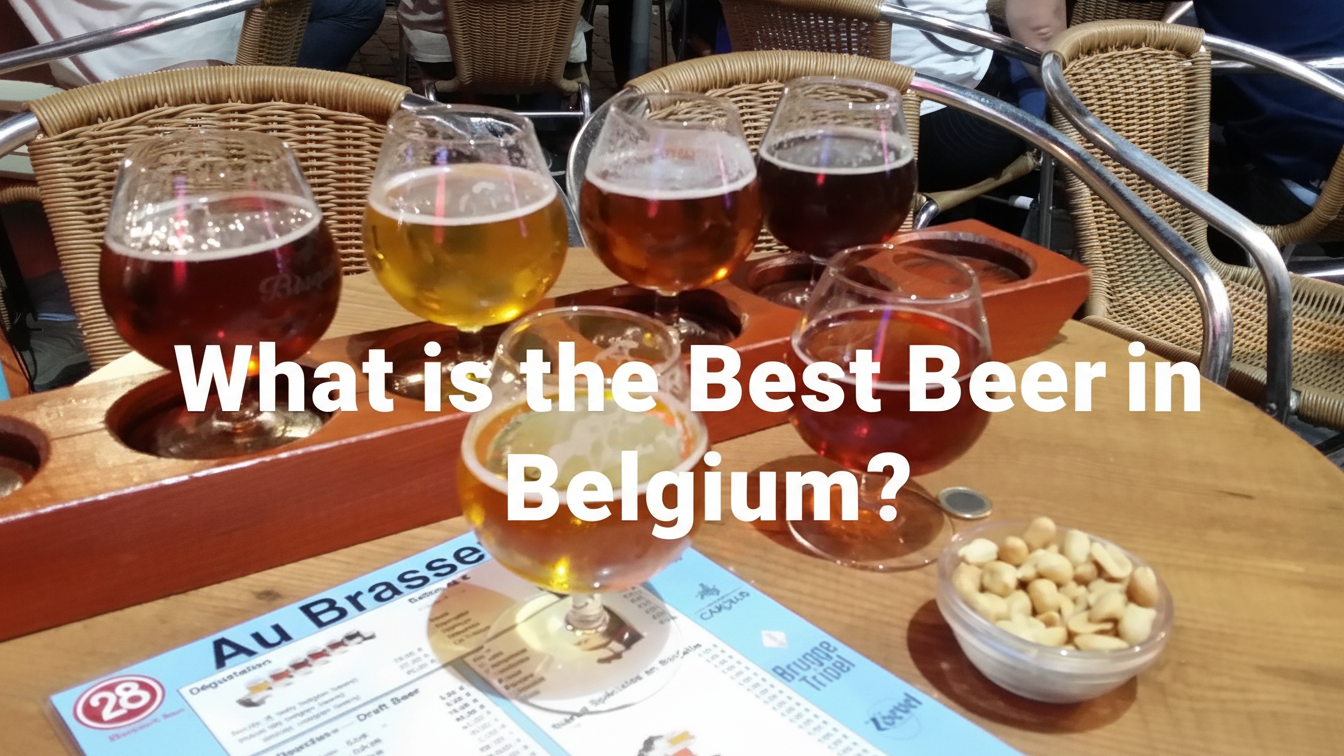Belgium is well known for its brewing tradition. Belgium is regarded as the beer capital of the world for a reason—it has a lengthy history of brewing and offers more than 1,500 distinct varieties. The beer industry in this country is incredibly varied, with various brewing customs and traditions existing in each area and even in each individual city. It can be difficult to choose the finest beer in Belgium because there are so many options available. This piece will examine the origins of Belgian beer, the various varieties that are offered, and then make an attempt to resolve the age-old query, What is the best beer in Belgium?
If you would like to know what to do and see while visiting Brussels. We have written an article and you can click here to for some helpful hints on must see things to do.
A Brief History of Belgian Beer
Beer-brewing in Belgium has a lengthy history that dates to the Middle Ages. Monasteries that brewed beer as a means of self-sufficiency helped to create the nation’s brewing tradition. Through centuries of practice, the monks’ brewing abilities led to the creation of distinctive brewing methods and formulas that are still used today.
With the addition of novel ingredients and brewing techniques, Belgian beer has developed over time. The customary gruit blend of herbs and spices that was used to flavor beer was replaced in the 16th century by hops. New beer varieties, such as the pale ale and the saison, were created as a result.
Brewers could make beer on a larger scale in the 19th century thanks to the development of new technologies like pasteurisation and refrigeration. Due to this, the Belgian brewing industry was able to take off and rapidly establish a reputation for producing high-quality beer.
More than 200 breweries produce various beer types in Belgium today. Belgian beer is among the finest in the world and is exported all over the world.
Types of Belgian Beer
Belgian beer has a huge variety of available beer styles, making it extremely diverse. Some of the most famous Belgian beer varieties are listed below:
Trappist Beer
The distinctive beer known as “Trappist beer” is produced by Trappist nuns in their monasteries all over Belgium. Trappist beer is brewed using traditional techniques, and the monks, who follow strict quality standards, carefully monitor the production process.
Westmalle, Chimay, Orval, Rochefort, Achel, and Westvleteren are just a few of the world-famous Trappist brews made by the six Belgian Trappist breweries. Each brewery makes a variety of brews with various flavors and alcohol concentrations.
The complicated flavor profile of trappist beer, which frequently includes hints of fruit, spice, and caramel, is what makes it unique. The beer usually contains a lot of alcohol, with ABVs between 5% and 12%.
Many beer connoisseurs around the globe consider Trappist beer to be some of the best in the world. Trappist beer is not only delicious, but it also helps support the monasteries because the money from beer purchases supports the monks’ way of life and their charitable endeavors.
Lambic
A spontaneous fermentation procedure is used to create the distinctive and traditional Belgian beer style known as lambic. In other words, rather than being added to the beer by the brewer, the beer is fermented using wild yeasts that are already prevalent in the air.
Unmalted wheat makes up a significant part of lambic beer, which gives it is distinctively tart and funky flavor. The beer’s prolonged ageing in wooden casks for several years further complicates the flavor profile.
To produce a variety of styles, including gueuze and fruit lambics, lambic beer is frequently blended with other beers. Gueuze is a mixture of immature and aged lambic beers, whereas fruit lambics are created by ageing beer with fruit, such as cherries or raspberries.
The sour and funky flavor character of lambic beer makes it an acquired taste that not everyone enjoys. Lambic beer is a special and delicious beer with a rich history in Belgian brewing, according to those who appreciate it.
Saison
The Belgian beer style known as “saison” got its start in Wallonia, which is a French-speaking area. Farmworkers, or “saisonniers,” would typically brew it in the winter and drink it in the summer.
The light, bubbly texture and fruity, spicy flavors of saison beer are well-known. It is usually brewed with a variety of grains, such as rye and wheat, as well as a blend of spices and hops. The beer frequently undergoes bottle conditioning, which involves continuing the fermentation process inside the container to give it a distinctive complexity and depth of flavor.
In recent years, craft brewers have produced a variety of saison beers, which have grown in popularity. Its crisp, fruity flavors are especially alluring in the warmer months, and its adaptability and refreshing taste have made it a favorite among beer drinkers all over the globe.
Witbier
Witbier is a type of Belgian wheat beer made with a significant amount of wheat, coriander, and orange peel. Due to the fact that it is typically unfiltered, it has a cloudy look and a smooth, creamy mouthfeel.
Witbier is renowned for its light body, minimal bitterness, and refreshing and crisp flavor. The beer is given a light citrusy tang and subtle spiciness by the coriander and orange zest, making it ideal for summertime consumption.
The beer known as witbier was created in the village of Hoegaarden in the 18th century and nearly vanished in the middle of the 20th. In contrast, it saw a surge in favor in the 1960s and 1970s and is now a mainstay of Belgian brewing.
In order to create distinctive and intriguing variations of the traditional Belgian witbier, many craft breweries all over the world have begun to produce their own takes on the style by adding extra flavors like herbs or fruits.
Dubbel
Dubbel is a variety of beer that was first produced in Belgium. It is distinguished by its dark amber hue and full, malty flavor. One of the traditional beers made in the Trappist fashion by Belgian monks using regional ingredients and time-tested methods. The normal alcohol content of dubbel is between moderate and high, and it has a complex aroma and flavor that includes notes of caramel, dark fruit, and spices like coriander and clove. Although it is a well-liked style in Belgium and other areas of Europe, Dubbel has gained popularity among craft beer lovers everywhere and is frequently brewed by independent breweries using their own distinctive twists on the style.
Tripel
Belgian-born Tripel beer is a robust pale ale that’s renowned for both its high alcohol level and distinctive flavour profile. Tripel, a traditional Trappist beer style brewed by Belgian monks, is similar to Dubbel in that it is a classic. Its characteristics include its golden hue, effervescence, and fruity aroma, which, based on the formula, can be anything from spicy to floral. Tripel frequently has an alcohol level above 8%, giving it a warming, boozy flavor that is countered by its sweetness and hop bitterness. Independent breweries all over the world frequently produce this popular style, which is beloved by craft beer fans.
Belgian Strong Ale
Belgian Strong Ale is a type of beer distinguished by its high alcohol level and intricate flavor profile. It is a broad category that contains numerous distinct sub-styles, each with its own distinctive qualities, such as Tripel, Dubbel, and Quadrupel. Belgian Strong Ales are typically brewed with a mixture of malted barley and other cereals, such as wheat or oats, and are frequently flavored with spices, herbs, or fruit. They come in a variety of hues, from golden to dark brown, and can taste or smell sweet, peppery, fruity, or malty. Craft beer fans frequently age Belgian Strong Ales in barrels to give them more flavor complexity and depth. They are a flexible style that can be paired with a variety of foods, from spicily spiced Thai curries to decadent chocolate desserts, or savored on their own.
Conclusion: Given the enormous variety and high calibre of Belgian beer, identifying the best beer in Belgium is a difficult job. While Belgium is home to many excellent beers, some of the most well-known and respected ones include Trappist ales like Westvleteren 12 and Chimay Blue as well as bitter beers like Cantillon and Rodenbach. Belgian beer culture is rooted in heritage, and many breweries employ distinctive brewing methods and ingredients to produce distinctive flavor profiles. The best Belgian beer ultimately comes down to personal taste, and the best way to find your favorite brew is to explore Belgium’s vibrant and diverse beer scene.



















